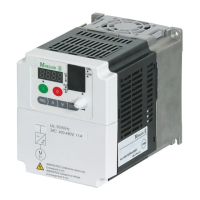09/01 AWB8230-1412GB
49
5 Programming the control signal terminals
This section describes how to assign various functions to the
control signal terminals.
Overview
Table 9 provides an overview of the control signal terminals and a
brief description of the functions which you can assign to the
programmable digital inputs and outputs. For a detailed descrip-
tion of the individual functions, see from Page 52.
Table 9: Function description
Name Value
1)
Function Description
Digital inputs 1 to 5 Parameter definition under PNU C01 to C05
FWD 00 Clockwise
(start/stop)
REV 01 Anticlockwise
(start/stop)
FWD input closed: motor starts up in a clockwise direction.
FWD input open: motor coasts to a stop (clockwise rotation).
REV input: same case for anticlockwise rotation as with FWD
FWD and REV inputs closed simultaneously: motor coasts to a stop.
FF1 02 Programmable fixed
frequencies 1 to 4
Example: Four fixed frequencies
FF2 03
f
s
=0 to f
max
FF3 04
FF4 05
For four fixed frequency stages (three programmable fixed frequencies and a setpoint value), two
fixed frequency inputs (3 = FF1 and 4 = FF2) are required (2
2
= 4).
JOG 06 Jog mode
The jogging mode, which is activated by switching on the JOG input, is used, for example, for
setting up a machine in manual mode. When a start signal is received, the frequency programmed
under PNU A38 is applied to the motor. Under PNU A39, you can select one of three different
operating modes for stopping the motor.
2CH 09 Second time ramp
Activates the second acceleration and deceleration with PNU A92 and PNU A93 respectively
FRS 11 Controller inhibit (free
run stop)
When FRS is switched on, the motor is immediately switched off and coasts to a stop.
REV
FWD
P2412
FWD
f
REV
M
M
FF1
FF2
FWD
f
1
f
2
f
3
f
s
f
FF2
RST
FF1
REV
FWD
P241234LOH5
f
s

